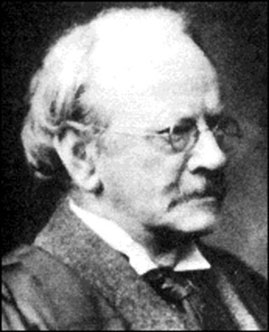| J. J. Thomson  AKA Joseph John Thomson AKA Joseph John Thomson
Born: 18-Dec-1856
Birthplace: Cheetham Hill, England
Died: 30-Aug-1940
Location of death: Cambridge, Cambridgeshire, England
Cause of death: unspecified
Remains: Buried, Westminster Abbey, London, England
Gender: Male
Religion: Anglican/Episcopalian
Race or Ethnicity: White
Sexual orientation: Straight
Occupation: Physicist Nationality: England
Executive summary: Discovered the electron Beginning in 1895 physicist J. J. Thomson theorized that cathode rays produced in Crookes' tubes must be composed of what he called "corpuscles", a single type of negatively charged particle. In 1897, applying his own vacuum technique to the study of these then-mysterious rays, Thomson made a convincing argument for composition based on sub-atomic particles, "this matter being the substance from which all the chemical elements are built up".
To make sense of this theory he proposed a "plum pudding model" of the atom, which was debated for several years and disproved by his former student, Ernest Rutherford. Thomson also showed a stream of channel rays could be separated into two or more parts through exposure to electrical and magnetic fields, leading eventually to the invention of the mass spectrograph and discovery of isotopes by another of Thomson's students, Francis W. Aston. Thomson won the Nobel Prize in Physics in 1906, and his son, physicist George Paget Thomson, won the same honor in 1937. Father: Joseph James Thomson (bookseller, d. 1872)
Mother: Emma Thomson
Wife: Rose Elizabeth Paget (lab student, m. 22-Jan-1890, one son, one daughter)
Son: George Paget Thomson (physicist)
Daughter: Joan Paget Thomson
University: Victoria University of Manchester
University: BA Mathematics, Trinity College, Cambridge University (1880)
Fellow: Trinity College, Cambridge University (1880-1918)
Professor: Cavendish Professor of Physics, Cambridge University (1884-1919)
Lecturer: Physics, Princeton University (1896, four lectures)
Lecturer: Physics, Yale University (1904, six lectures)
Administrator: Master, Trinity College, Cambridge University (1918-40)
Cambridge and St John's Adams Prize 1884
Royal Medal 1894
Hughes Medal 1902
Smithsonian Hodgkins Medal 1902
Nobel Prize for Physics 1906
Knighthood 1908
Order of Merit 1912
Copley Medal 1914
John Scott Medal 1923
Benjamin Franklin Medal 1923 (by the Franklin Institute)
Mascart Medal of the Societe Francaise des Electriciens 1927
Manchester John Dalton Medal 1931
IET Faraday Medal 1938
British Association for the Advancement of Science President (1909)
Royal Institution of Great Britain
Royal Society 1884
Royal Society President (1916-20)
Scottish Ancestry
Author of books:
Elements of the Mathematical Theory of Electricity and Magnetism (1895, physics)
Properties of Matter (1895, physics text; with J. H. Poynting)
Discharge of Electricity through Gases (1897, physics)
Conduction of Electricity through Gases (1903, physics)
The Structure of Light (1907, physics)
The Corpuscular Theory of Matter (1907, physics)
Rays of Positive Electricity (1913, physics)
The Electron in Chemistry (1923, physics)
Recollections and Reflections (1936, memoir)
Requires Flash 7+ and Javascript.
Do you know something we don't?
Submit a correction or make a comment about this profile
Copyright ©2019 Soylent Communications
|